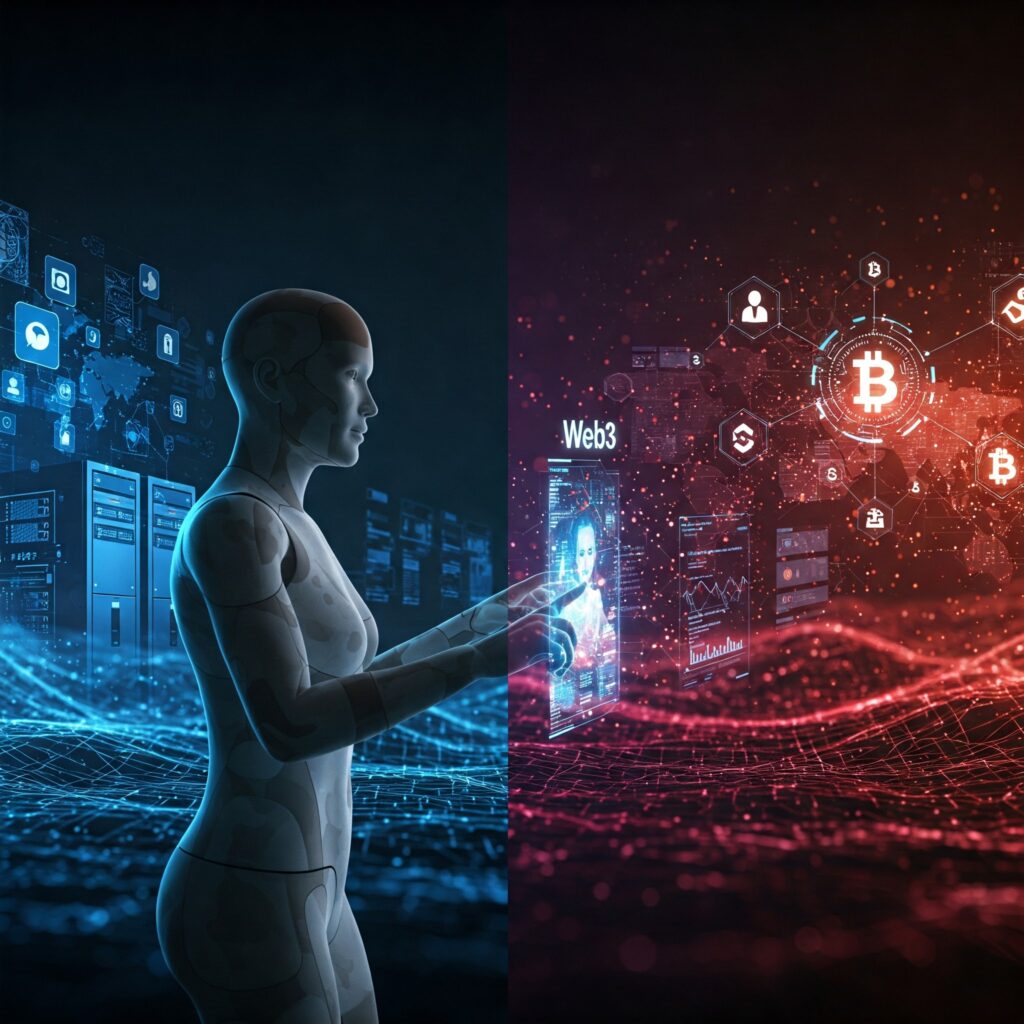What is Web3? How Blockchain & Cryptocurrency Are Changing the Internet

Introduction
Imagine a world where you have full control over your online identity and data. A world where middlemen like banks, social media platforms, and big tech companies no longer control your digital life. This is the vision of Web3.
The internet has evolved rapidly over the years. We started with Web1, a static and read-only version of the internet. Then came Web2, the interactive and social web, dominated by companies like Facebook, Google, and Amazon. Now, Web3 promises a decentralized future, powered by blockchain and cryptocurrency.
In this article, you’ll learn what Web3 is, why it’s important, and how it’s changing the internet. We’ll cover the benefits, practical applications, challenges, and what the future holds for Web3.

Understanding Web3
What is Web3?
Web3 is the next generation of the internet, built on blockchain technology. It aims to create a decentralized web where users have more control over their data, finances, and digital identity.
In Web2, companies store your personal information on their servers. They can sell it, use it for targeted ads, or even ban your account. Web3 removes the need for these intermediaries by using decentralized networks.
The Role of Blockchain & Cryptocurrency
Blockchain is a digital ledger that records transactions in a secure and transparent way. It powers cryptocurrencies like Bitcoin and Ethereum. In Web3, blockchain technology enables smart contracts, decentralized apps (dApps), and digital ownership.
Cryptocurrencies play a major role in Web3. Instead of using traditional payment methods, people can use crypto tokens to buy, sell, or access online services. This removes the need for banks and reduces transaction fees.
Why Does Web3 Matter?
Web3 is important because it shifts power from big corporations to individuals. It gives users more control, increases security, and opens up new opportunities for earning money online. With Web3, you own your data, transactions are more transparent, and censorship is nearly impossible.
Key Benefits of Web3
1. Decentralization
Web3 removes the need for central authorities. Instead of companies storing your data, it’s spread across a blockchain network, making it more secure and resistant to hacking.
2. Data Ownership & Privacy
In Web3, you control your data. No more selling your personal information without consent. Decentralized identity solutions allow users to manage their online presence without third-party interference.
3. Financial Freedom
With Web3, you don’t need a bank to store or send money. Cryptocurrencies allow peer-to-peer transactions without intermediaries, making finance more accessible to people worldwide.
4. Transparency & Security
Since blockchain records transactions publicly, everything is transparent and difficult to alter. This makes fraud and corruption harder.
5. New Ways to Earn Money
Web3 introduces new income opportunities like play-to-earn games, staking, yield farming, and decentralized finance (DeFi). Users can earn tokens for contributing to networks, playing games, or providing liquidity.
Step-by-Step Guide: How to Get Started with Web3
1. Get a Web3 Wallet
To interact with Web3 applications, you need a crypto wallet like MetaMask, Trust Wallet, or Coinbase Wallet. These wallets store your digital assets and allow you to access dApps.
2. Buy Cryptocurrency
You’ll need crypto tokens like Ethereum (ETH) or Solana (SOL) to use Web3 services. You can buy them on exchanges like Binance, Coinbase, or Kraken.
3. Explore Decentralized Applications (dApps)
Try out Web3 applications like Uniswap (for decentralized trading), OpenSea (for NFTs), or Aave (for lending and borrowing crypto).
4. Join Web3 Communities
Follow discussions on Twitter, Discord, and Telegram groups. Staying updated with the Web3 space helps you discover new projects and trends.
5. Experiment with NFTs & DeFi
Non-Fungible Tokens (NFTs) allow you to buy, sell, and trade unique digital assets. Decentralized Finance (DeFi) platforms let you earn interest on your crypto assets.
Common Problems & Solutions in Web3
1. High Transaction Fees (Gas Fees)
Problem: Some blockchain networks charge high fees for transactions. Solution: Use Layer 2 solutions like Polygon or alternative blockchains like Solana with lower fees.
2. Complexity & Learning Curve
Problem: Web3 technology can be confusing for beginners. Solution: Start with user-friendly apps, follow guides, and join Web3 communities for support.
3. Security Risks & Scams
Problem: Many scams and phishing attacks target Web3 users. Solution: Always double-check website URLs, never share your private keys, and use hardware wallets for added security.
Future Trends in Web3
1. Mass Adoption of Decentralized Apps (dApps)
More people and companies are adopting Web3 applications, making them easier to use and more accessible.
2. Growth of the Metaverse
Virtual worlds like Decentraland and The Sandbox are building decentralized spaces where people can work, socialize, and trade digital assets.
3. Regulations & Legal Frameworks
Governments are starting to create regulations for Web3 to ensure security and prevent fraud while maintaining decentralization.
4. Integration with AI & IoT
Artificial Intelligence (AI) and the Internet of Things (IoT) will combine with Web3 to create smarter, more automated digital ecosystems.
Conclusion & Final Thoughts
Web3 is changing how we use the internet by making it decentralized, transparent, and user-controlled. Blockchain and cryptocurrency power this revolution, giving people more financial freedom and data ownership.
If you want to be part of this exciting new era, start by setting up a Web3 wallet, exploring dApps, and learning about decentralized finance. The future of the internet is here, and now is the perfect time to get involved.
FAQ
1. What is the main goal of Web3?
Web3 aims to decentralize the internet, giving users more control over their data and digital assets.
2. How does blockchain power Web3?
Blockchain stores data in a decentralized way, enabling secure transactions, smart contracts, and decentralized applications.
3. Is Web3 the same as cryptocurrency?
No, Web3 is a broader concept that includes blockchain, decentralized apps, and digital identity. Cryptocurrency is just one part of Web3.
4. What are the risks of Web3?
Web3 has risks like scams, high fees, and security vulnerabilities. Always do research before using Web3 apps.
5. How can I start using Web3?
You can start by setting up a Web3 wallet, buying crypto, and exploring decentralized apps like Uniswap or OpenSea.